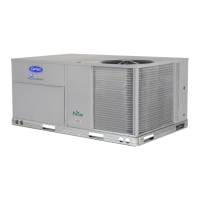61
Connecting Discrete Inputs —
Filter Status: The filter status accessory is a
field--installed accessory. This accessory detects plugged
filters. When installing this accessory, the unit must be
configured for filter status by setting
MENU
Config
Inputs
input3,5,8,or9to Filter
Status and normally open (N/O) or normally closed (N/C).
Input 8 or 9 is recommended for ease of installation. Refer
to Fig. 69 and Fig. 70 or 71 for wire termination s at J5 .
Fan Status: The fan status accessory is a field--installed
accessory. This accessory det ects when t he indoor fan is
blowing air. When installing this accessory, the unit must
be configured for fan status by setting
MENU
Config
Inputs
input3,5,8,or9to Fan Status
and normally open (N/O) or normally closed (N/C). Input 8
or 9 is recommended for ease of installation. Refer to Fig.
69 and Fig. 70 or Fig. 71 for wire terminations at J5.
Remote Occupancy: The remote occupancy accessory is
a field--installed accessory. This accessory overrides the
unoccupi ed mode and puts t he unit in occupied mode.
When installing this accessory, the unit must be
configured for remote occupancy by setting
MENU
Config
Inputs
input3,5,8,or9to Remote
Occupancy and normally open (N/O) or normally c losed
(N/C).
Also set MENU
Schedules
occupancy source to DI
on/off. Input 8 or 9 is rec ommended for ease of
installation. Refer to Fig. 69 and Table 23 for wire
terminations at J5.
Power Exhaust (output): The relay used by the RTU
Open controller board to control power exhaust i s a dry
conta ct which means it does not have 24vac. This 24vac
must be connected to the relay to allow it to operate the
power exhaust relay in the PE accessory. A 24vac source
must be provided to J11--2 on t he RTU Open controller
board. This can be provided by the unit’s transformer from
various sources. The “R” terminal on the unit’s c entral
terminal board (CTB) i s a logical source. Refer to Fig. 69
and Fig. 70 or 71 for wire terminations at J11.
Communication Wiring -- Protocols
General —
Protocols are the communication languages spoken by
control devic es. The main purpose of a protocol is to
communicate information in the most efficient method
possible. Different protocols exist to provide different
kinds of information for di fferent applications. In the BAS
application, many different protocol s are used, depending
on manufacturer. Protocols do not change the function of
a controller; they just make the front end user different.
The RTU Open controller can be set to communicate on
four different protoc ols: BACnet , Modbus, N2, and
LonWorks. Switch 3 (SW3) on the board is used to set
protocol and baud rate. Switches 1 and 2 (SW1 and SW2)
are used to set the board’s network address. See Fig. 80
and 81 for protocol switch settings and address switches.
The third pa rty connection to the RTU Open controller is
through plug J19. See Fig. 82 for wiring.
NOTE: Power must be cycled after changing the SW1--3
switch settings.
Refer to the RTU Open v3 Integration Guide for more
detailed information on proto cols , third party wiring, and
networking.
SW3 Protocol Selection
PROTOCOL DS8 DS7 DS6 DS5 DS4 DS3 DS2 DS1
BACnet MS/TP
(Master)
Unused OFF OFF OFF ON OFF Select Baud Select Baud
Modbus
(Slave)
Unused OFF OFF ON ON OFF Select Baud Select Baud
N2
(Slave)
Unused OFF OFF OFF ON ON OFF OFF
LonWorks Unused ON ON OFF ON OFF OFF ON
NOTE:
DS = Dip Switch
BACnet MS/TP SW3 example shown
Baud Rate Selections
BAUD RATE DS2 DS1
9600 OFF OFF
19,200 ON OFF
38,400 OFF ON
76,800 ON ON
C07166
Fig. 80 -- RTU Open Controller SW3 Dip Switch Settings

